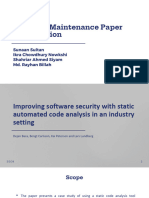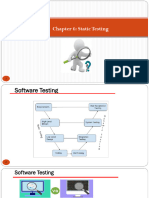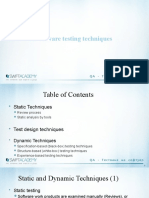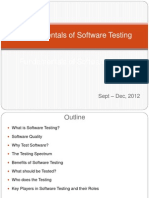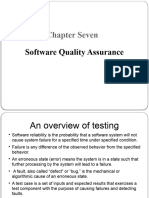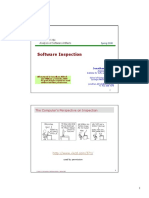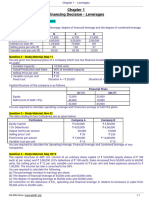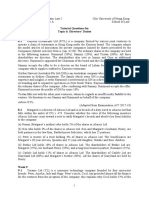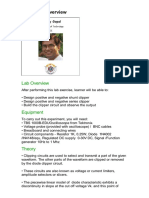The Role of Static Code Analysis in
Improving Software Quality and
Security
CONTENTS
1. Introduction 2. Key Research Findings 3. References
01
Introduction
Introduction
This research paper discusses how Static Code Analysis (SCA) can be utilized to enhance the quality and security of software. This
research can be structured into a step-by-step process comprising three steps, i.e. selection of the topic, initial research (Weeks 1-3),
extensive research and writing (Weeks 4-6), and final review and presentation (Weeks 6-9). The results demonstrate advantages of
SCA tools in improving the reliability of software, reducing costs, and hardening security practices, and the primary limitations, such as
false positives, scalability, and tool integration. The topicality of the combination of SCA and dynamic analysis and artificial
intelligence techniques in the future is also supported by the insights provided in the industry and academic literature.
02
Key Research Findings
Weeks 1-3: Topic Selection and Early Research
The topic of this research project is Static Code Analysis (SCA).
Weeks 1-3: Topic Selection and Early Research
Why Static Code Analysis?
SCA was chosen because it is a necessary component of software engineering and security practice today. In contrast to dynamic
analysis where software is assessed when it is running, SCA is used to analyze the source code without running the software, which
thus detects any problems at an early stage in the development life cycle.
Weeks 1-3: Topic Selection and Early Research
Initial Findings
Software Quality Assurance (SQA): Compliance: It assists organizations in Cost Efficiency: It is cheaper to
SCA is widely used. adhering to global standards (ISO/IEC address bugs detected early than
25010, OWASP guidelines). after deployment.
A brief presentation summarizing these premature findings and establishing the direction of the research was made by the end of
Week 3.
Weeks 4-6: Research and Draft Summary
In Weeks 4-6, research was undertaken in detail with reference to academic articles, industry reports, and tool documentation.
Weeks 4-6: Research and Draft
Summary
Concept and Purpose
SCA inspects code for:
Bugs and Errors: logical errors, dead code, etc.
SQL Injection Vulnerabilities: SQL injection, buffer overflow, data leakage.
Coding Standard Compliance: This renders SCA a proactive form of quality
assurance that conserves time and money when developing the software.
Weeks 4-6: Research and Draft Summary
Machinery and Industry Arts
The most popular SCA tools are:
1 SonarQube 2 Fortify
The best to use with CI/CD pipelines, and fits well with High security orientation, which is common in sensitive
Jenkins and GitHub Actions. industries such as finance and aviation.
3 PMD and ESLint 4 Coverity
Lightweight tools primarily used to enforce coding Common with large-size projects.
standards.
Case Studies: Companies that have implemented the idea of SCA in their DevOps pipelines have seen a decline in the number of
production defects by a factor of 30-40 percent.
Weeks 4-6: Research and Draft Summary
The Benefits of Static Code Analysis
Better Quality of Code: Identifies dead code, overly Additional Security: Detects vulnerabilities before they can be
complicated structures, and bad code patterns. exploited by attackers.
Cost-Effectiveness: Boehm in his Defect Cost Model asserts Knowledge Transfer: Assists in quickly converting new
that it is 10x more expensive to fix bugs during development developers to the practice of coding in teams.
than during production.
Weeks 4-6: Research and Draft Summary
Challenges and Limitations
1 2
False Positives: False alarms can be as high as 35 percent, Scalability Problems: Bigger codebases take longer and use
which can be frustrating to the developer. more computing resources.
3 4
Little Context Awareness: Tools do not have complete
Integration Complexity: Agile/DevOps custom configurations.
knowledge of runtime behavior.
Insights from Literature
An IEEE Software study published in 2021 announced that both dynamic and static analysis are more accurate when used together.
SCA is adopting AI/ML to minimize false positives and be trained to code patterns. The increasing relevance of SCA in microservices is
reflected in multi-language projects (Java + Python + JavaScript).
Weeks 6-9: Final Review, and Preparation of
Presentation
At the last stage, the study was edited and summarized into a systematic report and presentation.
Weeks 6-9: Final Review, and Preparation of Presentation
Emphasis in the Final Presentation
1 2
Definition & Purpose of SCA Tools and Practices Used in Industry
3 4
Benefits and Cost Savings Challenges and Limitations
5 6
Academic Research Knowledge
Future Horizon: AI/ML integration and multi-language project support.
This is the research that I gathered through learning and conducting searches.
03
References
References
1
OSWAP, Static code analysis, 2021, OWASP Static Code Analysis
TechTarget, What is static code analysis, 2023, TechTarget
IEEE, Analysis of tool static analysis, IEEE
Thank You





